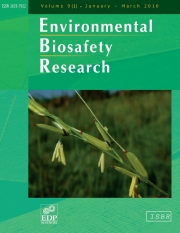Article contents
Meteorological input data requirements to predict cross-pollination of GMO Maize with Lagrangian approaches
Published online by Cambridge University Press: 17 March 2007
Abstract
Modeling pollen dispersal to predict cross-pollination is of great importance for the ongoing discussion of adventitious presence of genetically modified material in food and feed. Two different modeling approaches for pollen dispersal were used to simulate two years of data for the rate of cross-pollination of non-GM maize (Zea mays (L.)) fields by pollen from a central 1 ha transgenic field. The models combine the processes of wind pollen dispersal (transport) and pollen competition. Both models used for the simulation of pollen dispersal were Lagrangian approaches: a stochastic particle Lagrange model and a Lagrangian transfer function model. Both modeling approaches proved to be appropriate for the simulation of the cross-pollination rates. However, model performance differed significantly between years. We considered different complexity in meteorological input data. Predictions compare well with experimental results for all simplification steps, except that systematic deviations occurred when only main wind direction was used. Concluding, it can be pointed out that both models might be adapted to other pollen dispersal experiments of different crops and plot sizes, when wind direction statistics are available. However, calibration of certain model parameters is necessary.
Information
- Type
- Research Article
- Information
- Copyright
- © ISBR, EDP Sciences, 2007
References
- 10
- Cited by

